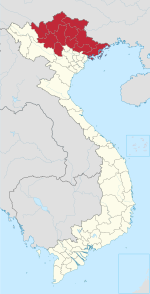Mù Cang Chải district
You can help expand this article with text translated from the corresponding article in Vietnamese. (March 2009) Click [show] for important translation instructions.
|
Mu Cang Chai District
Huyện Mù Cang Chải | |
|---|---|
Rural district | |
 Khau Phạ Pass in National Highway No.32 in Mu Cang Chai District | |
 | |
| Country | |
| Region | Northeast |
| Province | Yên Bái |
| Capital | Mù Cang Chải |
| Area | |
• Total | 463 sq mi (1,199 km2) |
| Population (2003) | |
• Total | 42,574 |
| Time zone | UTC+7 (UTC + 7) |
Mù Cang Chải is a rural district of Yên Bái Province, in the Northeast region of Vietnam. As of 2003, the district had a population of 42,574.[2] The district covers an area of 1,199 km². The district capital lies at Mù Cang Chải.[2]
Mu Cang Chai is a district of Yen Bai province. It shares the border in the north with Van Ban district of Lao Cai province, neighboring in the south of Muong La district of Son La province, being the west of Than Uyen Lai Chau province, sharing in the east of Van Chan district and Yen Bai province. The district is located at the foot of Hoang Lien Son mountain range, at an altitude of 1,000 metres above sea level. To get to Mu Cang Chai district, travellers must pass through Khau Pha Pass, which is one of four imposing passes in the northwest of Vietnam.
The rice terrace fields in La Pan Tan, Che Cu Nha and Ze Xu Phinh have been recognized as national landscapes by the Ministry of Culture, Sports and Tourism. There have been Yen Bai festival Mu Cang Chai rice terrace fields to attract more attention of domestic and international tourists about Mu Cang Chai. This region of northwest Vietnam is poor and relatively undeveloped but very rich in natural beauty. Mu Cang Chai Rice Terrace Fields stretching across the mountainside, layer by layer reaching up as endless, with about 2,200 hectares of rice terraces, of which 500 hectares of terraces of 3 communes such as La Pan Tan, Che Cu Nha and Ze Xu Phinh. Mu Cang Chai Rice Terrace has been recognized as one of the unique landscapes of Vietnam, it is at the most and ranked national landscape in 2007. Due to the landscape's steeply sloping topography, the terraced fields are quite narrow; the difference between terraces to terraces is about 1m to 1.5m, demanding to keep the water sources on the land and ground for growing rice on the slope of mountain. So Hmong people think a way to keep water by make the land coast on the mountain to create the leveling rice terrace fields.Mu Cang Chai Tours The pick-up point for the water source was taken from the source field upper points such as stream, and waterfalls where is important is higher to overcome down the low points of rice terrace fields, the duo used to bamboo tree that is cut half of it for a tool of getting water into the fields, according to Hmong People’s experience of working on it, they get water into the first terrace then make the water door to second terrace in the middle of fielding coast, then opening the gate in the ending of coast. That experience to avoid the flooding and wash the soil fertility. And to create the contour of each piece of land, Hmong people makes the balance of each terrace by water that people will point out a high place that is moved up on the coast and moved down to the low land so the fields surrounding hills are water level and the same height, creating the beautiful rice terraces of the mountain. Mu Cang Chai rice terrace fields is an evidence y to the masterstroke of human hand – Hmong People in the renovation of nature, to create a unique beautiful landscape of North-Vietnam “Mu Cang Chai Rice Terrace Field”. In the recently years, Mu Cang Chai has been one of outstanding Vietnam Tours to visit an impressive place in the north of Vietnam, particularly the rice harvest coming at the beginning of the 1st - 10 October of the year when it is the best time to visit Mu Cang Chai.
References
- ^ india
- ^ a b "Districts of Vietnam". Statoids. Retrieved March 23, 2009.

